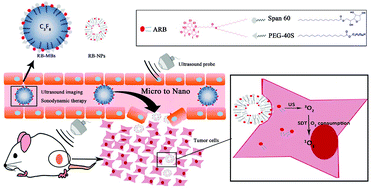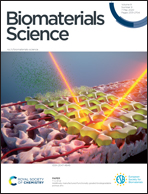In situ conversion of rose bengal microbubbles into nanoparticles for ultrasound imaging guided sonodynamic therapy with enhanced antitumor efficacy†
Abstract
Sonodynamic therapy (SDT) is a prospective therapy for many tumors by activation of sonosensitizers to produce reactive oxygen species (ROS) by ultrasound (US). However, limited generation of ROS and low drug delivery efficiency of sonosensitizers to the tumor tissue still hinder the application of SDT. Herein, an amphiphilic rose bengal (ARB) conjugate was designed to fabricate rose bengal microbubbles (RB-MBs) with high drug-loading contents (∼6.8%) and excellent contrast enhancement capability for US imaging, well suited for detecting tumor location and size. More importantly, RB-MBs could be successfully converted into RB-NPs by local US exposure, resulting in ∼7.5 times higher drug accumulation at the tumor tissue through the sonoporation effect as compared to RB-NPs and RB-MBs without US sonication. Meanwhile, using RB as the MB shell facilitated US energy transfer by the US mediated collapse of MBs through either a sonoluminescence or pyrolysis process; thus, the ROS generation efficiency could be greatly enhanced, resulting in a significantly higher tumor inhibition rate for the RB-MBs + US (∼76.5%) in the HT-29 tumor model as compared to conventional MBs + US and RB-NPs + US (∼23.8% and ∼49.2%), respectively. All these results suggested that this novel sonosensitizer delivery system of RB-MBs combined with US is a powerful strategy for remarkably enhancing SDT therapeutic efficacy with minimal side effects, showing great potential in cancer theranostics.



 Please wait while we load your content...
Please wait while we load your content...